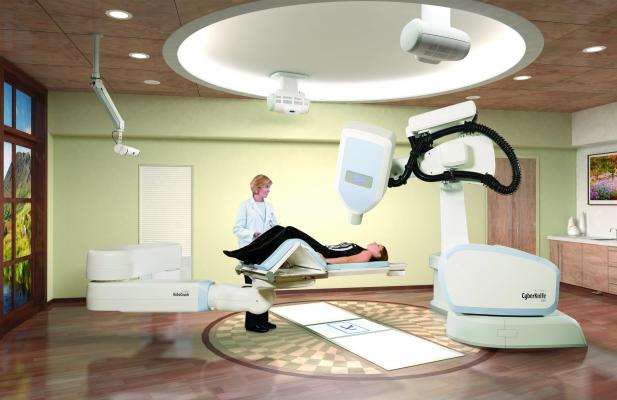
April 28, 2016 — Alliance Oncology, a division of Alliance HealthCare Services Inc., announced that one of their radiation therapy centers, Reno CyberKnife, has upgraded their CyberKnife Robotic Radiosurgery System. Alliance HealthCare Services is a national provider of outsourced radiology, oncology and interventional services,
The CyberKnife System was upgraded from the 8.5 version to the 10.5 version, with extra features added, including the Lung Optimized Treatment (LOT) function, the IRIS II, MultiPlan V5.5 treatment planning system (TPS) and Xsight Spine Prone.
The Lung Optimized Treatment package is a suite of software that provides a complete fiducial-free clinical solution for most lung cancer patients. Because fiducial implantation is no longer required, CyberKnife radiosurgery with Lung Optimized Treatment offers a completely noninvasive option, which is particularly important for medically or surgically inoperable patients. It enables physicians with greater flexibility in delivering radiosurgery treatments to patients with lung cancer, the most common and deadly cancer worldwide.
“Our CyberKnife upgrade will add versatility to our options on how we treat our lung cancer patients, allowing us to individualize and optimize patient care,” said Jonathan Tay, M.D., co-medical director at Reno CyberKnife.
The IRIS II is a feature that will help provide better quality treatment, as well as shorten it. The IRIS II is a variable-aperture collimator, which uses two offset banks of six prismatic tungsten leaves to form a blurred regular dodecagon field of variable size, which eliminates the need for changing the fixed collimators. With the new IRIS II, the CyberKnife only needs to travel around the tumor in one trip and the IRIS II can change the field sizes as needed, allowing for a short and smooth treatment. In addition, this feature grants the clinical team the choice of as many as nine various sizes of radiation beams to treat a tumor, compared to up to three sizes using fixed collimators. The extra flexibility improves the quality of treatment plans, particularly for irregular-shaped tumors.
The MultiPlan Treatment Planning System enables the clinical team (physicist, radiation oncologist and surgeon, among others) to generate high-quality CyberKnife treatment plans with a stronger computation power and a better optimization algorithm. Flexible and individualized treatment plans can be created quickly and intuitively, resulting in a fast and accurate treatment delivery for the patient. Other key features of the MultiPlan is that it offers remote tools that allow the physician to remotely run the TPS from any location, provide enhanced communication capabilities, and give CyberKnife centers the ability to collaborate and outreach to remote facilities and physicians.
The Xsight Spine Prone tracking system provides tracking of tumors in or near the spine, allowing patients to be treated in the prone position (lying with the chest down and back up). Delivering radiation to a posterior target, such as tumors in or near the spine, with the patient in the supine position (lying face up), results in a high number of monitor units per beam, which could induce a high dose of radiation to the surrounding healthy tissue. Other patient benefits of the Xsight Spine Prone include: its targeting accuracy (1.5 mm); a noninvasive method of delivering spine radiosurgery; faster with less complex treatments; and it provides an additional treatment option for those who are not candidates for surgery or conventional radiation therapy.
For more information: www.cyberknife.com


 March 28, 2024
March 28, 2024 








